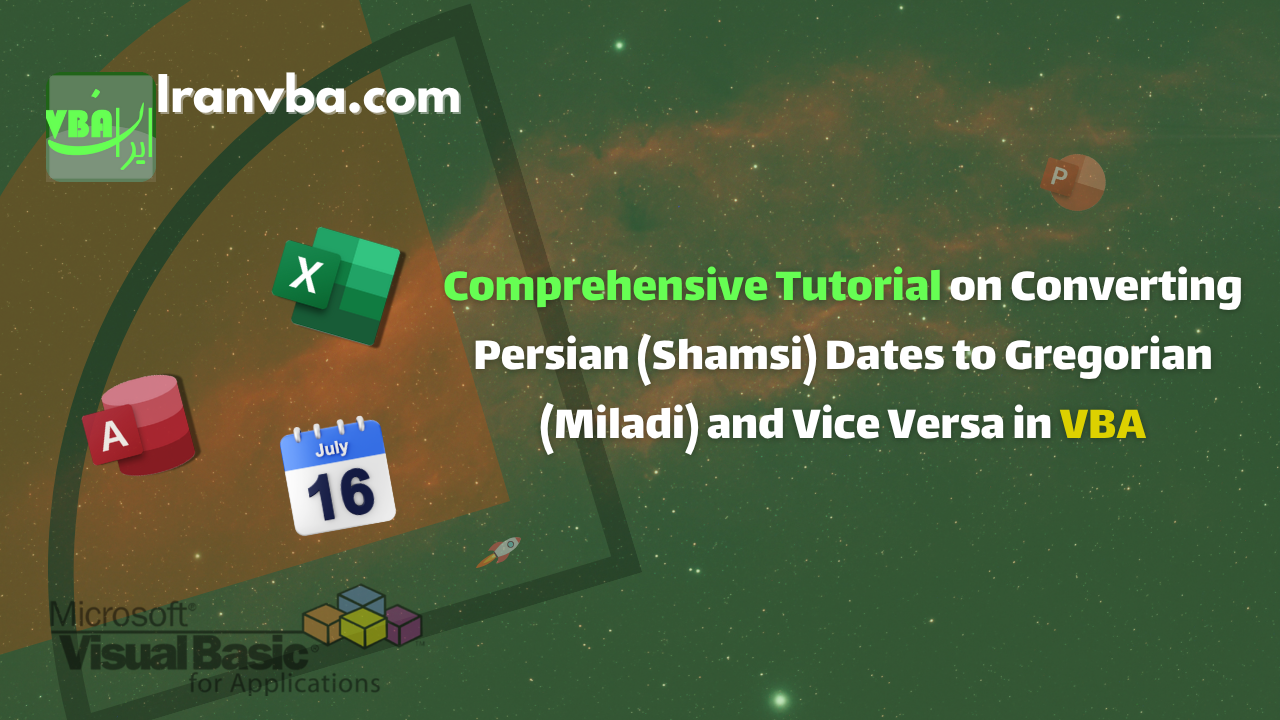Converting dates between different calendars is a common need in programming, especially for developers working with Iranian systems. In this tutorial post, we will review a complete and professional module for converting Persian (Jalali) dates to Gregorian (Miladi) dates and vice versa.
📑 Table of Contents
- Introduction and Module Overview
- General Structure and Initial Definitions
- Function to Detect Persian Leap Year
- Function to Convert Gregorian to Persian (JalaliCalendar)
- Function to Convert Persian to Gregorian
- How to Use the Functions
- Practical Examples
- Complete Module Code
- Tutorial Video on How to Transfer and Use the Module Functions for Converting Persian to Gregorian Dates in Excel
- Summary
Introduction and Module Overview
This module, named DateConvertor, is designed for use in the VBA Access environment and enables accurate date conversion between the Persian and Gregorian calendars. The module uses a Gregorian base year (21-03-1921) to calculate the Persian date. The base date is considered in both Persian and Gregorian formats, and the time difference between the Gregorian base year and the input Gregorian date is calculated as the number of days. Then, using a loop and based on the Computational Arithmetic Calendar algorithm designed by Mousa Akrami, it determines whether the Persian year is a leap year or not, and then converts the number of days back to the Persian year, month, and day.
Option Explicit
'=============================================================='
'Module Purpose: Convert Persian dates to Gregorian and vice versa'
'Creation Date: 18-05-1397 (08-09-2018)'
'Persian Date Origin: 01-01-1300'
'Gregorian Date Origin: 21-03-1921'
'=============================================================='General Structure and Initial Definitions
The module begins with the definition of global variables and an Enum for the output type:
Dim calcYear As Variant
Dim JCDaysCount As Long
Dim JCMonth As Integer
Dim JCYear As Integer
Dim JCRemainDays As Integer
'... and other variables
Enum jCalendar_returnValueType
jcSplitArray = 1 'Output as Array'
jcNumber = 2 'Output as Number'
jcString = 3 'Output as String'
End EnumFunction to Detect Persian Leap Year
The first important function is the leap year detection function, which works based on astronomical calculations:
Public Function JalaliKabise(Yr As Integer) As Boolean
calcYear = (Yr + 2346) * (0.24219858156)
calcYear = calcYear - Int(calcYear)
If calcYear < 0.24219858156 Then
JalaliKabise = True
Else
JalaliKabise = False
End If
End FunctionThis function uses a precise mathematical algorithm to determine whether the input Persian year is a leap year or not.
Function to Convert Gregorian to Persian (JalaliCalendar)
The main function for converting Gregorian dates to Persian is the JalaliCalendar function. This function takes two arguments named InputDate and returnValueType. The InputDate argument is the input Gregorian date and its data type must be Date. The returnValueType argument is of the custom data type jCalendar_returnValueType, which is an Enum and can have three values: jcSplitArray, jcNumber, and jcString. It has three main stages for converting a Gregorian date to Persian:
Stage 1: Calculate Days Passed from the Origin
JCDaysCount = DateDiff("d", #3/21/1921#, InputDate) + 1
JCYear = 1300Stage 2: Convert Days to Persian Year
Do Until JCDaysCount < 365
If JalaliKabise(JCYear) = True
Then D = 366
Else
D = 365
End If
If JCDaysCount - D > 0 Then
JCDaysCount = JCDaysCount - D
JCYear = JCYear + 1
Else
Exit Do
End If
LoopStage 3: Convert to Persian Month and Day
' For the first 6 months of the year (31 days)
If (JCRemainDays > 31 And JCRemainDays <= 186) Then
JCMonth = 1
Do Until JCRemainDays <= 31
JCRemainDays = JCRemainDays - 31
JCMonth = JCMonth + 1
Loop
End IfFunction to Convert Persian to Gregorian
This function also has similar but reverse stages:
Stage 1: Extract Date Components
GCJalaliDay = Right(inJalaliDate, 2)
GCJalaliMonth = Mid(inJalaliDate, 5, 2)
GCJalaliYear = Left(inJalaliDate, 4)Stage 2: Validate Input Date
' Control day and month range
If GCJalaliDay > 31 Or GCJalaliMonth > 12 Then
GregorianCalendar = "False"
Exit Function
End If
' Control days of Esfand month
If GCJalaliMonth = 12 Then
If JalaliKabise(GCJalaliYear) = False Then
If GCJalaliDay > 29 Then
GregorianCalendar = "False"
Exit Function
End If
End If
End IfHow to Use the Functions
The input date format for the functions must be YYYYMMDD. Example: 14030615 for the date 15 Shahrivar 1403.
Possible Output Types
' 1. String output
Dim strDate As String
strDate = JalaliCalendar(Date, jcString) ' Result: "Saturday 15 Shahrivar 1403"
' 2. Numeric output
Dim numDate As Long
numDate = JalaliCalendar(Date, jcNumber) ' Result: 14030615
' 3. Array output
Dim arrDate() As String
arrDate = Split(JalaliCalendar(Date, jcSplitArray), "!") ' Result: Array containing "15", "6", "1403"Practical Examples
Example 1: Display Today’s Date in Persian
Sub ShowTodayJalali()
Dim todayJalali As String
todayJalali = JalaliCalendar(Date, jcString)
MsgBox "Today: " & todayJalali
End SubExample 2: Convert Persian Date to Gregorian
Sub ConvertToGregorian()
Dim jalaliDate As Long
Dim gregorianDate As Date
jalaliDate = 14030615 ' 15 Shahrivar 1403
gregorianDate = GregorianCalendar(jalaliDate, True)
MsgBox "Gregorian Date: " & Format(gregorianDate, "dd/mm/yyyy")
End SubExample 3: Calculate Age
Function CalculateAge(birthDate As Long) As Integer
Dim todayJalali As Long
todayJalali = JalaliCalendar(Date, jcNumber)
Dim age As Integer
age = (todayJalali - birthDate) \ 10000
CalculateAge = age
End FunctionComplete Module Code
Option Explicit
'=============================================================='
'module target: convert Jalali date to Gregorian and vice versa'
'module created by Sadegh Abshenas''''''''''''''''''''''''''''''
'Jalali base date: 01-01-1300'''''''''''''''''''''''''''''''''''
'Gregorian base date: 21-03-1921''''''''''''''''''''''''''''''''
'=============================================================='
Dim calcYear As Variant
Dim j As Integer
Dim bytDay As Byte
Dim bytMonth As Byte
Dim intYear As Integer
Dim D As Integer
Dim JCDaysCount As Long
Dim JCMonth As Integer
Dim JCYear As Integer
Dim JCRemainDays As Integer
Dim bytDayOfWeek As Byte
Dim strFaMonth As String
Dim strFaDay As String
Dim GCYear As Integer
Dim GCDaysCount As Long
Dim GCMonth As Integer
Dim GCYearNow As Integer
Dim GCDayNow As Integer
Dim GCMonthNow As Integer
Dim GCJalaliNow As String
Dim arrGCJalaliNow() As String
Dim GCcalculateDate As Date
Dim GCJalaliDay As Integer
Dim GCJalaliMonth As Integer
Dim GCJalaliYear As Integer
Dim strJCMonth As String
Dim strJCRemainDays As String
Enum jCalendar_returnValueType
jcSplitArray = 1
jcNumber = 2
jcString = 3
End Enum
Public Function JalaliKabise(Yr As Integer) As Boolean
calcYear = (Yr + 2346) * (0.24219858156)
calcYear = calcYear - Int(calcYear)
If calcYear < 0.24219858156 Then
'MsgBox "This year is a leap year"
JalaliKabise = True
Else
'MsgBox "This year is not a leap year"
JalaliKabise = False
End If
End Function
'----------------------------------------------------------------------
'important note for JalaliCalendar Function: inputArgs help
'there is two method to work with this function
'method 1: input date must seprate into day, month and year
'on this method first 3 Args must fill and bolDateFormat set to false
'returnValueType just change return value format, if set to true return
'value seprate into string variable with ! as Separator
'method 2: a date variable set as input value (last args)
'on this method last 2 args must fill and bolDateFormat must set to true
'----------------------------------------------------------------------
Public Function JalaliCalendar(InputDate As Date, Optional returnValueType As jCalendar_returnValueType = jcString) As Variant
' Calculate the difference in days between the calculation origin date and the input date of the function
JCDaysCount = DateDiff("d", #3/21/1921#, InputDate) + 1
'JCDaysCount = DateDiff("d", #3/21/2010#, Now) + 1 'note Calculate days from origin date to today based on Gregorian
JCYear = 1300 'note Persian calendar origin year
'note In the first stage, the days passed from the Gregorian origin must be converted to Persian year, day, and month.
Do Until JCDaysCount < 365 'note Loop until the calculated days from the origin are less than 365
If JalaliKabise(JCYear) = True Then 'note Check for leap year for each year
D = 366 'note Days in a leap year
Else
D = 365 'note Days in a non-leap year
End If
If JCDaysCount - D > 0 Then 'note If the difference in days equals one year, we should exit the loop
JCDaysCount = JCDaysCount - D 'note Subtract the year's days from the total days passed from the origin and add one year to the year number
JCYear = JCYear + 1
Else
Exit Do
End If
Loop
JCRemainDays = JCDaysCount
If (JCRemainDays <= 31) Then
JCMonth = 1
End If
If (JCRemainDays > 31 And JCRemainDays <= 186) Then
JCMonth = 1
Do Until JCRemainDays <= 31
JCRemainDays = JCRemainDays - 31
JCMonth = JCMonth + 1
Loop
End If
If (JCRemainDays > 186 And JCRemainDays <= 336) Then
JCMonth = 7
JCRemainDays = JCRemainDays - 186
Do Until JCRemainDays <= 30
JCRemainDays = JCRemainDays - 30
JCMonth = JCMonth + 1
Loop
End If
If (JCRemainDays > 336 And JCRemainDays < 365) Then
JCMonth = 12
JCRemainDays = JCRemainDays - 336
End If
If JCRemainDays = 365 Then
JCMonth = 12
JCRemainDays = 29
End If
If JCRemainDays = 366 Then
If JalaliKabise(JCYear) = True Then
JCMonth = 12
JCRemainDays = 30
Else
JCMonth = 1
JCRemainDays = 1
JCYear = JCYear + 1
End If
End If
bytDayOfWeek = Format(InputDate, "w", vbSaturday)
If returnValueType = jcSplitArray Then
JalaliCalendar = JCRemainDays & "!" & JCMonth & "!" & JCYear
Exit Function
End If
If returnValueType = jcNumber Then
If JCMonth < 10 Then
strJCMonth = 0 & JCMonth
Else
strJCMonth = JCMonth
End If
If JCRemainDays < 10 Then
strJCRemainDays = 0 & JCRemainDays
Else
strJCRemainDays = JCRemainDays
End If
JalaliCalendar = JCYear & strJCMonth & strJCRemainDays
Exit Function
End If
Select Case JCMonth
Case 1
strFaMonth = "Farvardin"
Case 2
strFaMonth = "Ordibehesht"
Case 3
strFaMonth = "Khordad"
Case 4
strFaMonth = "Tir"
Case 5
strFaMonth = "Mordad"
Case 6
strFaMonth = "Shahrivar"
Case 7
strFaMonth = "Mehr"
Case 8
strFaMonth = "Aban"
Case 9
strFaMonth = "Azar"
Case 10
strFaMonth = "Dey"
Case 11
strFaMonth = "Bahman"
Case 12
strFaMonth = "Esfand"
End Select
Select Case bytDayOfWeek
Case 1
strFaDay = "Saturday"
Case 2
strFaDay = "Sunday"
Case 3
strFaDay = "Monday"
Case 4
strFaDay = "Tuesday"
Case 5
strFaDay = "Wednesday"
Case 6
strFaDay = "Thursday"
Case 7
strFaDay = "Friday"
End Select
If returnValueType = jcString Then
JalaliCalendar = strFaDay & " " & JCRemainDays & " " & strFaMonth & " " & JCYear
End If
End Function
Public Function GregorianCalendar(inJalaliDate As Long, jalaliDateToGregorian As Boolean) As Variant
GCJalaliDay = Right(inJalaliDate, 2)
GCJalaliMonth = Mid(inJalaliDate, 5, 2)
GCJalaliYear = Left(inJalaliDate, 4)
'note Initial controls for month and day
'--------------------------------------------------------------------------
If GCJalaliDay > 31 Or GCJalaliMonth > 12 Then
GregorianCalendar = "False"
MsgBox "Input date is incorrect", vbCritical
Exit Function
End If
If GCJalaliDay = 0 Or GCJalaliMonth = 0 Or GCJalaliYear < 1300 Then 'note Initial controls for month and day
GregorianCalendar = "False"
MsgBox "Input date is incorrect", vbCritical
Exit Function
End If
If GCJalaliMonth > 6 Then 'note Control input days of the function based on the input month
If GCJalaliDay > 30 Then
GregorianCalendar = "False"
MsgBox "Input date is incorrect", vbCritical
Exit Function
End If
End If
If GCJalaliMonth = 12 Then 'note Control days of Esfand month for non-leap years to not exceed 29 days
If JalaliKabise(GCJalaliYear) = False Then
If GCJalaliDay > 29 Then
GregorianCalendar = "False"
MsgBox "The number of days for Esfand month has not been entered correctly", vbCritical
Exit Function
End If
End If
End If
'--------------------------------------------------------------------------
'note End of initial controls
'note Start of date conversion to days
'note In the first stage, the days passed from the Persian calendar origin must be calculated
'note The considered Persian calendar origin is the beginning of the year 1300
GCDaysCount = 0
GCYear = 1300
Do Until GCYear = GCJalaliYear
If JalaliKabise(GCYear) = True Then 'note Check for leap year for each year
D = 366 'note Days in a leap year
Else
D = 365 'note Days in a non-leap year
End If
GCDaysCount = GCDaysCount + D
GCYear = GCYear + 1
Loop
'note The result of the above loop is the total days passed from the Persian origin to the desired date in the function argument
'note In the following lines, the month must be converted to days
GCMonth = GCJalaliMonth - 1
If GCMonth <> 0 Then 'note Here, the number of days for the target month in the function argument is calculated, provided it is not 1 (i.e., Farvardin)
Select Case GCMonth
Case 1 'note If the month is Farvardin, add 31 days to the days
GCDaysCount = GCDaysCount + 31
Case 2
GCDaysCount = GCDaysCount + 62
Case 3
GCDaysCount = GCDaysCount + 93
Case 4
GCDaysCount = GCDaysCount + 124
Case 5
GCDaysCount = GCDaysCount + 155
Case 6
GCDaysCount = GCDaysCount + 186
Case 7
GCDaysCount = GCDaysCount + 216
Case 8
GCDaysCount = GCDaysCount + 246
Case 9
GCDaysCount = GCDaysCount + 276
Case 10
GCDaysCount = GCDaysCount + 306
Case 11
GCDaysCount = GCDaysCount + 336
End Select
End If
'note Add the days of the function argument to the total days
GCDaysCount = GCDaysCount + GCJalaliDay
'note Convert the entered Persian date to Gregorian by adding the calculated days to the Gregorian origin
GCcalculateDate = DateAdd("d", GCDaysCount - 1, #3/21/1921#)
If jalaliDateToGregorian = True Then
GregorianCalendar = GCcalculateDate 'note Gregorian date as function output
Exit Function
End If
'note Convert today's Gregorian date to Persian to determine if the input date of the function is not after today's date
GCJalaliNow = JalaliCalendar(Now, jcSplitArray)
arrGCJalaliNow = Split(GCJalaliNow, "!")
GCDayNow = arrGCJalaliNow(0)
GCMonthNow = arrGCJalaliNow(1)
GCYearNow = arrGCJalaliNow(2)
'note Compare today's date and the function's input date and determine the correct user input
'----------------------------------------------------------------------------
If GCYearNow < GCJalaliYear Then
MsgBox "Future date cannot be entered", vbCritical
GregorianCalendar = "False"
Exit Function
End If
If GCYearNow = GCJalaliYear Then
If GCMonthNow < GCJalaliMonth Then
MsgBox "Future date cannot be entered", vbCritical
GregorianCalendar = "False"
Exit Function
End If
End If
If GCYearNow = GCJalaliYear Then
If GCMonthNow = GCJalaliMonth Then
If GCDayNow < GCJalaliDay Then
MsgBox "Future date cannot be entered", vbCritical
GregorianCalendar = "False"
Exit Function
End If
End If
End If
'note End of comparison
'----------------------------------------------------------------------------
'note Assign value to the function
GregorianCalendar = JalaliCalendar(GCcalculateDate, jcString)
End Function
Public Function JCDateDiff(firstDate As Long, secoundDate As Long)
JCDateDiff = DateDiff("d", _
GregorianCalendar(firstDate, True), _
GregorianCalendar(secoundDate, True), _
vbSaturday)
End Function
Tutorial Video on How to Transfer and Use the Module Functions for Converting Persian to Gregorian Dates in Excel
Summary
This module provides a complete tool for working with Persian and Gregorian dates in the VBA environment. Using this code, you can:
- Convert Gregorian dates to Persian
- Convert Persian dates to Gregorian
- Detect Persian leap years
- Calculate the difference between two Persian dates
- Validate Persian dates
This module can be used in various projects such as accounting systems, management programs, and any application that requires working with Persian dates.
Read More
How to Access Data from Another Excel File in VBA?
How to Convert Excel Files to PDF Using VBA?
Developer Tab in Excel | How to Enable the Developer Tab in Excel
VBA Editor | How to Open the Visual Basic Code Editor?



